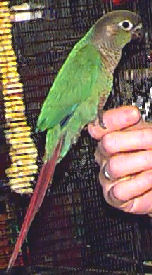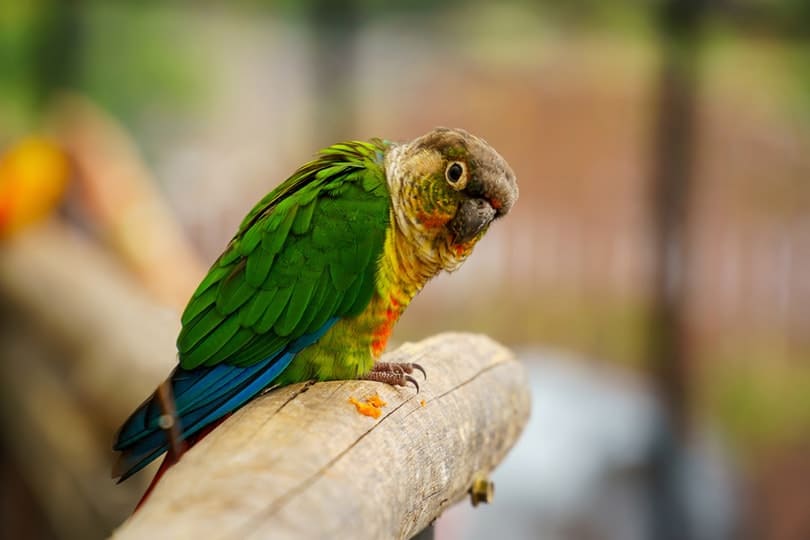
“Pooki” is just about four months old and he is so darn playful,… he can’t wait to be let out of his cage!
ÂÂ “Pooki” has all the wonderful characteristics of the popular Green-cheeked Conures. They are quite smart little birds, and come up with very creative solutions to a variety of situations. For example, often times Pookie just can’t wait another minute for his good morning, so often times he simply lets himself out of his cage!
His new home is with a young girl who is “graduating” from cockatiels to a bit bigger bird. Both she and Pooki are very excited about getting to know each other and getting to play with each other!
For more information about the care of Conures see:
Guide to a Happy, Healthy Conure
Learn About Green Cheeked Conure – as part of the expert series by GeoBeats.
- Kingdom: Animalia
- Phylum: Chordata
- Class: Aves
- Order: Psittaciformes
- Family: Psittacidae
- Genus: Pyrrhura
- Species: molinae
Scientific Name:
Subspecies:
- Green-cheeked Conure
Pyrrhura molinae molinae - Argentina Conure
Pyrrhura molinae australis - Santa Cruz Conure
Pyrrhura molinae restricta - Yellow-sided Conure
Pyrrhura molinae hypoxantha - Pyrrhura molinae sordida
- Pyrrhura molinae phoenicura
Distribution:
These birds are native to Bolivia.
Description:
The Green-cheeked has coloring very similar to the Maroon-bellied Conure, but can be distinguished by the reddish upper surface of its’ tail feathers. It has a green body with blue primary flight feathers and a maroon tail. The scallop feathers on the chest and upper neck are fringed with white. There is purple on the belly and the beak and the ear covers are brown.
Size – Weight:
These birds grow to a length of 10 1/2″ (26.2 cm).
Care and feeding:
A roomy cage is required unless the bird is to be let out for extended periods. Many birds can spend most of their time on a play pen or parrot perch. They eat a variety of seeds, nuts, fruits, and commercial pellets, as well as the same nutritional foods humans eat.
See About Conures: Housing and About Conures: Care and Feeding for more information.
Social Behaviors:
These birds tame very easily and are very sociable. The Pyrrhuras are a quieter conure than the Aratinga species making them an easier pet to live with. However, they are not known to be great talkers. In the wild they are very sociable with other green-cheeks. Often they forage in groups and spend the night sleeping together.
Activities:
Loves to climb and play. Provide lots of toys. 
Breeding/Reproduction:
The sex of the Green-cheeked Conure is undeterminable by appearance, though an immature bird will have duller pulmage than the adult, darker irises, and less maroonish coloring on there abdomen. These birds reach sexual maturity around two years of age. The hen will usually lay between four to six eggs, and the incubation period averages 22 – 25 days.The average clutch is 4–6 eggs. Average incubation is 24 days, varying from 22 to 25 days. They are not too fussy about their nesting box but can use a box about 7″ x 7″.
Potential Problems:
This bird is not nearly as noisy as most Aratinga species.
See About Conures: Potential Problems for more information.
Availability:
This bird is generally available.
Featured Image Credit: Ismail Rajo, Shutterstock
